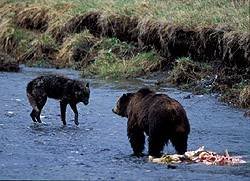Mugniyah is probably the most intelligent, most capable operative we’ve ever run across, including the KGB or anybody else. He enters by one door, exits by another, changes his cars daily, never makes appointments on a telephone, never is predictable. He only uses people that are related to him that he can trust. He doesn’t just recruit people. He is the master terrorist, the grail that we have been after since 1983 And here is what an Israeli Intelligence had to say about Mughniyeh in 2001, speculating that he had been part of the planning along with al Qaeda for 9-11: . . . Mughniyeh is probably the world’s most wanted outlaw. Unconfirmed reports in Beirut say he has undergone plastic surgery and is unrecognisable. . . Read the entire article. The assassination today of Mughniyeh, in Damascus by a car bomb is suspected to be the handiwork of Mossad. See here for more. Israel is declining comment. An explosion rocked the Kferssouseh neighborhood in Damascus - near the Iranian school Tuesday evening And there is much more in a series of article in the Jerusalem Post about Mughniye's history of terrorism and his assassination. See here and here. The assassination of Imad Mughniyeh is a very big victory in the war on terror. Mughniyeh worked for al Qaeda, Iran, Fatah and was the number 2 man in Hezbollah. Short of bin Laden, Mughniyeh probably has more American blood on his hands than any other terrorist. His career spanned more than a quarter of a century, until he was killed today in a car bombing in Damascus.
The assassination of Imad Mughniyeh is a very big victory in the war on terror. Mughniyeh worked for al Qaeda, Iran, Fatah and was the number 2 man in Hezbollah. Short of bin Laden, Mughniyeh probably has more American blood on his hands than any other terrorist. His career spanned more than a quarter of a century, until he was killed today in a car bombing in Damascus.
-------------------------------------------------------------------------------------
For those who know the history of terrorism, the name of Imad Mughniyeh is immediately recognizable. Born in 1960, he is known to have been behind the 1983 bombings of the U.S. Embassy, and U.S. Marine and French peacekeeping barracks, which killed over 350, as well as the 1992 bombings of the Israeli embassy in Buenos Aires and the kidnapping of dozens of foreigners in Lebanon in the 1980s. He has been hunted by the U.S. since he engineered the kidnapping, torture and murder of CIA Lebanese Station Chief William Buckley in 1984. According to ex-CIA agent Robert Baer:
"We’ve only got scraps of information, not the full picture," admits one intelligence source, "but it was good enough for us to send a warning six weeks ago to our allies that an unprecedented massive terror attack was expected. One of our indications suggested that Imad Mughniyeh met with some of his dormant agents on secret trips to Germany. We believe that the operational brains behind the New-York attack were Mughniyeh and Zawahiri, . . .
. . . "Bin Laden is a schoolboy in comparison with Mughniyeh," says an Israeli who knows Mughniyeh . "The guy is a genius, someone who refined the art of terrorism to its utmost level. We studied him and reached the conclusion that he is a clinical psychopath motivated by uncontrollable psychological reasons, which we have given up trying to understand. The killing of his two brothers by the Americans only inflamed his strong motivation."
. . . Mughniyeh, 48, is a "sick man", says an intelligence officer who was in charge of his file. He is considered by Western intelligence agencies as the most dangerous active terrorist today. He is wanted by several governments and the Americans have put a $2m reward on his head.
. . . It was the assassination of one man in March 1984 that is said to have made Mughniyeh the CIA’s most wanted terrorist. Mughniyeh allegedly kidnapped the head of the CIA station in Beirut, William Buckley. The kidnapping triggered what later became known as ‘Irangate’, when the Americans tried to exchange Buckley (and others) with arms for Iran. However, the attempt ended in a fiasco. By one unconfirmed account, Mughniyeh tortured and killed Buckley with his own hands.
A year later, in a combined CIA/Mossad operation, a powerful car bomb went off at the entrance to the house of Hizbullah’s spiritual leader, Sheikh Muhammad Hussein Fadlallah. Seventy-five people were killed. One of them was his brother. Hunted by the CIA and the Mossad, Mughniyeh hid in Iran.
In February 1992, Israeli helicopter gunships attacked the convoy of the then head of Hizbullah, Sheikh Abas Musawi, in South Lebanon. Musawi, his wife and children were killed and the revenge attack followed a month later. According to press reports, Mughniyeh was called back into action and, in a well-planned and devastating attack, his people blew up the Israeli embassy in Argentina. The building was demolished and 92 were killed. Only last year, after a long investigation, did Argentina issue a warrant for Mughniyeh’s arrest.
The reprisal for the attack in Argentina came in December 1994, when a car bomb went off in a southern Shi’ite suburb of Beirut. Four people were killed. One of them was called Mughniyeh, but to the deep disappointment of those Israelis who planted the bomb it was the wrong one. Mughniyeh’s life was saved, but his other brother Fuad was killed. Mughniyeh waited for his opportunity for revenge.
. . . How to counter this kind of terrorism? "To fight these bastards you don’t need a military attack," said an experienced Israeli commando officer. "You only need to adopt Israel’s assassination policy."
A report in the Lebanese newspaper Ya Liban comments dryly:
One person was killed as a result of the explosion .
No one declared responsibility .
The news about an explosion in Syria came as a big shock to many people in Lebanon. All the explosions for the past 3 years occurred in Lebanon and Syria was blamed for all of them . . .
Wednesday, February 13, 2008
Master Terrorist Imad Mughniyeh Assassinated
Posted by
GW
at
Wednesday, February 13, 2008
3
comments
![]()
Labels: al Qaeda, assassination, cia, Fatah, Hezbollah, Iran, Israel, Israeli Embassy, Lebanon, Marine Barracks, Mossad, Mughnyeh, Syria, terrorism, terrorist, William Buckley
Friday, December 21, 2007
Der Spiegel Interviews a Teenage Iraqi Terrorist
 There is an interesting interview in Der Spiegel of a teenage boy who was recruited to become a terrorist. Unfortunately, the article does not go into detail about what group recruited the boy or many additional specifics, but it is an interesting read nonetheless, if for not then all the contradictions apparent in the article - among them: the boy's hatred of Americans in respect of the fact that its the presence of Americans near his jail that assures him good treatment; the boy would like to visit America; and the real possibility that this would be killer may in fact be straightened out by a few whacks on his thick skull by an irate father:
There is an interesting interview in Der Spiegel of a teenage boy who was recruited to become a terrorist. Unfortunately, the article does not go into detail about what group recruited the boy or many additional specifics, but it is an interesting read nonetheless, if for not then all the contradictions apparent in the article - among them: the boy's hatred of Americans in respect of the fact that its the presence of Americans near his jail that assures him good treatment; the boy would like to visit America; and the real possibility that this would be killer may in fact be straightened out by a few whacks on his thick skull by an irate father:
Many of the insurgents building bombs and carrying out attacks in Iraq are hate-filled teenagers. Diya Muhammad Hussein, 16, is one of them.
. . . It was on a Wednesday a few weeks ago when Diya Muhammad Hussein went out to kill Americans. It was shortly after one o'clock in the morning and the curfew had just begun in the western Iraq town of Rawah. Diya crept out of his brother's house and walked to the tree where he had hidden the explosive device three days before.
It was a cold night, the 16-year-old recalls as he sits on the sofa of the police chief in his home town. After several hours a patrol of US Marines approached but Diya couldn't get the batteries back in the remote control unit fast enough. The Marines drove past unharmed.
. . . Diya calls himself a mujahedeen, a freedom fighter. The Iraqi government, the coalition troops, and the population exhausted by years of violence call him a terrorist. Diya's bomb could have killed several people, the US Marines say.
. . . A few hours later he was sitting in an Internet café with his friend Ahmed and was angry. The man who had incited him to commit the attack called him a coward in an Internet chat room conversation. Diya was unaware that the police has started monitoring such Internet contacts by local youths.
He was arrested as he left the Internet café to play football with Ahmed. He still had the remote control detonator in his coat pocket.
There are a number of possible reasons why the police chief of Rawah allowed us to interview Diya. For one, the US Marines asked him to, and they support the Iraqi police with a special training program as well as occasional equipment supplies, paying for an air conditioning unit here or a flashlight there. When the American friends make a request, it's hard to turn them down.
But the police chief is also proud of the arrest his officers made. Diya may look like just an ordinary teenager as he answers questions with his hands stuffed under his armpits, but his capture has averted a lot of harm. Diya led the police to an unusually large arsenal of weapons stored in plastic barrels buried in gardens. They contained a number of explosive devices, more than a dozen detonators, two precision rifles for snipers, Kalashnikovs, three grenades, 10 rockets, rocket launchers, TNT and a hundred hand grenades.
Diya went through what one could describe as the classic career of an Iraqi insurgent. About a year ago his father decided to take his wife and 11 children away from the increasing violence in Rawah and moved his family to a rural part of the country. There, in the small village of Hassah, Diya met Maad, an experienced fighter. The older man gained Diya's confidence and kept telling him how the Americans were godless occupiers. Fighting them was the duty of every Iraqi, he said.
Diya was thrilled, wanted to join the fight. As an initiation test into the group of local muhajedeen he was told to detonate a homemade mine. He recalls being told that he could one day attack the Marines as a suicide bomber, and didn't take that offer particularly seriously. "I found the notion strange, even funny," he says.
When Diya started preparing his first mission, he had a big network of helpers at his disposal. Rawah is a town like almost every other in Iraq -- everyone knows each other, and everyone knows who has been involved in the fight against the "occupiers" in the last few years. There's scarcely a family that doesn't have at least one son or cousin who worked as a henchman or leader of the local branch of "al-Qaida in Iraq" or other terror groups.
It was Ahmed's brother who told the boys about the weapons stashes, shortly before he was arrested as an insurgent. Diya learned how to use a detonator from Anas Fa'iq, another former fighter. His name is on a long list of wanted Iraqi Qaida members which is hanging in the US Marines' command headquarters.
Diya has been lucky in one respect. The building in which he is incarcerated also houses the company of Marines stationed in Rawah. They all live on the same floor: US Marines, Iraqi police and the prisoners. The Americans guarantee the prisoners at least a minimum of good treatment.
. . . "We still hate the Americans. In truth no one likes them. Iraq isn't free, that's why we have to keep on fighting," says Diya.
What would he do if he got a visa tomorrow to travel to the US? He would definitely take it, says Diya. Asked if he is aware of how contradictory that sounds, he smiles bashfully and buries his hands deeper into his armpits.
It's the irony of fate that Diya's brother became a policeman a few days after his arrest. They've rarely been closer than they are now. Diya squats in his cell behind a barred door while his brother stands guard outside.
"He spat on me when he saw me here," says Diya. His brother told him that his father is waiting for him to be released. "My father is beside himself with rage and will punish me severely, my brother said." . . .
Read the entire article.
(H/T Eye On The World)
Posted by
GW
at
Friday, December 21, 2007
0
comments
![]()
Labels: al Qaeda in Iraq, Der Spiegel, Iraq, Marines, recruit, terrorist
Monday, November 26, 2007
Counterterrorism Concerns in the UK
 In today's Telegraph, Peter Clarke, head of the Metropolitan Police's Counter Terrorism Command discusses his major worries across the pond:
In today's Telegraph, Peter Clarke, head of the Metropolitan Police's Counter Terrorism Command discusses his major worries across the pond:
. . . The abortive Glasgow bomb resulted in talk of an alleged "doctors' plot" among NHS professionals. Did this show that elements of the Muslim middle classes are at least as vulnerable to the call of radicalism as marginalised figures in the ghettoes?
"Middle-class bombs will kill just as well as working-class bombs," he retorts. "It show the dangers of profiling or stereotyping. What we've seen are people from all social classes, all educational standards and a whole host of nationalities. The only thing they have in common is a sense of grievance."
What about studies by the Joint Terrorism Analysis Centre — which consists of representatives from 11 Government departments and agencies — on radicalisation in prisons and universities?
"I'm very worried in both these cases. There is a prison population of 80,000. Muslims are around eight per cent of that, even though they number around three per cent of the general population.
"A tiny proportion of that eight per cent have been convicted of anything to do with terrorism. So I do worry about the pernicious influence of extremists."
He goes on to say there are two conflicting approaches. "Either you put them all together and you end up with a 'university of terror' or you disperse them and run the risk of such influences being spread everywhere." What about the threat of radicalisation in mainstream universities? He says: "We have seen significant members of terrorist networks in full-time education. It's still present and it's of great concern – but we need more study." . . .
Read the article. As to the issue of the Doctor's plot, recent research shows confirms neither socio-economic status nor degree of education correlate with whether a Muslim will become a terrorist. On a related note, the NYPD looked at the radicalization process in great detail in its report issued earlier this year. They also concluded that, because of the subtelties associated the radicalization process, it was difficult to develop a profile of the typical terrorist beyond exposure to and immersion in Salafi jihadi Islamist ideology.
Posted by
GW
at
Monday, November 26, 2007
0
comments
![]()
Labels: Counterterrorism, Metropolitan Police, NYPD, Peter Clarke, process, radicalization, Salafi, terrorist, Wahhabi














































